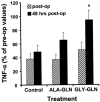Perioperative GLY-GLN infusion diminishes the surgery-induced period of immunosuppression: accelerated restoration of the lipopolysaccharide-stimulated tumor necrosis factor-alpha response
- PMID: 12496537
- PMCID: PMC1513970
- DOI: 10.1097/00000658-200301000-00015
Perioperative GLY-GLN infusion diminishes the surgery-induced period of immunosuppression: accelerated restoration of the lipopolysaccharide-stimulated tumor necrosis factor-alpha response
Abstract
Objective: To investigate whether the administration of different glutamine-containing dipeptides, glycyl-l-glutamine (GLY-GLN) and l-alanyl-l-glutamine, has a differing impact on perioperative immunomodulation.
Summary background data: Surgery leads to transitory immunosuppression, which is associated with decreased plasma glutamine (GLN) levels and increased susceptibility to infection and sepsis. A useful tool to detect immunocompetence is the ex vivo lipopolysaccharide (LPS)-stimulated tumor necrosis factor alpha (TNF-alpha) secretion in whole blood.
Methods: Forty-five patients undergoing major abdominal surgery were randomized prospectively to receive 0.5 g/kg/24 h GLN dipeptides administered as GLY-GLN or as ALA-GLN or isonitrogenous Vamin (a GLN-free amino acid solution; control group) as a continuous infusion over 72 hours, starting 24 hours before surgery. Blood samples were collected before infusion, at the end of surgery, and 48 hours postoperatively to determine the TNF-alpha release into whole blood stimulated with LPS. Groups were compared by analysis of variance.
Results: The groups were comparable in age, gender distribution, and length of operative time. At the end of surgery a significant reduction in ex vivo LPS-stimulated TNF-alpha production was observed in all groups. In patients who received GLY-GLN, the induced TNF-alpha production was restored after 48 hours.
Conclusions: In this study perioperative infusion of GLY-GLN reduced immunosuppression. The effect of GLN-containing dipeptides seems to be different when administered in glycine or alanine form.
Figures


References
-
- Cerami AC, Beutler B. Role of cachectin TNF in endotoxic shock and cachexia. Immunol Today 1988; 9: 28–31. - PubMed
-
- Fong Y, Lowry SF. Tumor necrosis factor in the pathophysiology of infection and sepsis. Clin Immunol Immunopathol 1990; 55: 157–170. - PubMed
-
- Akira S, Hirano T, Taga T, et al. Biology of multifunctional cytokines: IL-6 and related molecules (IL-1 and TNF). FASEB J 1990; 4: 2860–2867. - PubMed
-
- Hershman MJ, Cheadle WG, Wellhausen SR, et al. Monocyte HLA-DR expression characterizes clinical outcome in the trauma patient. Br J Surg 1990; 77: 204–207. - PubMed
-
- Kono K, Sekikawa T, Matsumoto Y. Influence of surgical stress on monocytes and complications of infection in patients with esophageal cancer: Monocyte HLA-DR antigen expression and respiratory burst capacity. J Surg Res 1995; 58: 275–280. - PubMed
Publication types
MeSH terms
Substances
LinkOut - more resources
Full Text Sources
Other Literature Sources
Medical

